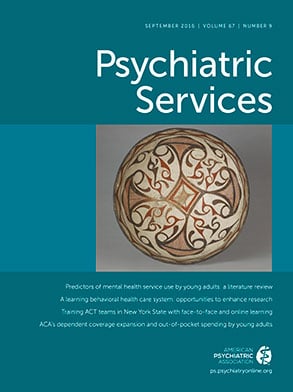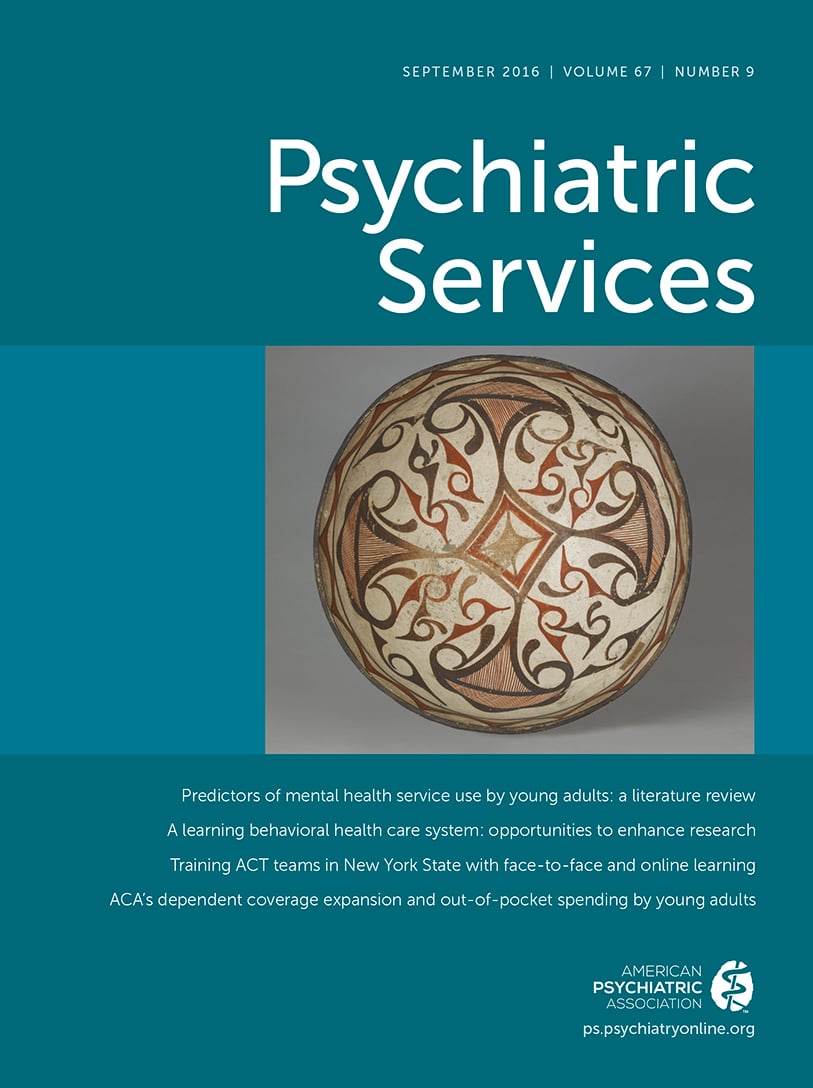Predictors of Mental Health Service Use by Young Adults: A Systematic Review
Abstract
Objective:
Methods:
Results:
Conclusions:
Methods
Literature Search
Inclusion Criteria
Data Collection and Quality Assessment
Statistical Analyses
Results
Sample Characteristics
| Study | Country | N in sample | Age (M) | Gender | Sample type (ascertainmenta) | Race-ethnicity | Mental health services | Period of use measured | Data source |
|---|---|---|---|---|---|---|---|---|---|
| Bergeron et al., 2005 (62) | Canada | 1,092 | ≥18 | Males, 498; females, 594 | Clinical (WMH-CIDI modified version) | Canadian, 94%; other, 6% | Mental health professionals, hospitalization | Past 12 months | Self-report |
| Biddle et al., 2004 (7) | UK | 444 | ≥18 | Males, 174; females, 270 | Clinical (GHQ-12; cutoff >4) | British | General practitioners | Past 4 weeks | Self-report |
| Downs and Eisenberg, 2012 (61) | US | 543 | ≥18 | Males, 179; females, 360; missing, 4 | Clinical (students with suicidal ideation) | Asian American, 6%; black American, 9%; Hispanic/Latino, 6%; multiracial, 11%; white, 6%; other, 8% | Therapy, counseling, psychotropic medications | Past 12 months | Self-report |
| Eisenberg et al., 2007 (60) | US | 2,785 | ≥18 | Not reported | Nonclinical | White, 61%; black, 6%; Asian, 20%; Hispanic, 4%; multiracial, 5%; other, 4% | Therapy, counseling, psychotropic medications | Past 12 months | Self-report |
| Eisenberg et al., 2011 (59) | US | 14,175 | ≥18 | Males, 6,152; females, 8,023 | Nonclinical | Asian American, 9%; black American, 6%; Hispanic, 8%; multiracial, 5%; other, 6%; white, 66% | Therapy, counseling, psychotropic medications | Past 12 months | Self-report |
| Flisher et al., 2002 (10) | South Africa | 905 | ≥19 | Males, 377; females, 528 | Clinical (students of university health services) | South African-black, 30%; colored, 13%; Indian, 4%; white, 53% | Psychiatrists or psychologists | Jan. 1, 1991–Dec. 31, 1993 | Medical records |
| Gayman et al., 2011 (29) | US | 672 | 20 | Males, 424; females, 248 | Clinical (DSM-IV) | White American, 34%; Cuban, 27%; Hispanic, 26%; African American, 13% | Medical doctors, mental health specialists, other professionals (for example, counselors) | Any time in the past | Self-report |
| Herman et al., 2011 (26) | US | 589 | 19.7 | Males, 194; females, 395 | Nonclinical | European American, 29%; Native Hawaiian, 18%; Japanese, 16%; Filipino, 11%; other Asian, 12%; other Pacific Islander, 7%; other, 7% | Counseling, psychiatric medications | Past 12 months and any time in the past | Self-report |
| Maulik et al., 2011 (65) | US | 500 | ≥18 | Males, 268; females, 230; missing, 2 | Nonclinical | African American, 95%; other, 5% | Mental health professionals, specialty clinics (for example, hospitals) | Past 12 months | Self-report |
| Mitchell et al., 2013 (64) | US | 166 | ≥18 | Not reported | Clinical (DSM-IV) | Not reported | 24-hour psychiatric emergency system | Any time in 2008 | Medical records |
| Miville and Constantine, 2006 (50) | US | 162 | 19.6 | Males, 59; females, 103 | Nonclinical | Mexican American | Professional psychological services (for example, counseling) | Past 12 months | Self-report |
| Oliver et al., 1999 (53) | US | 248 | ≥18 | Males, 67; females, 181 | Nonclinical | White, 85%; black, 7%; Hispanic, 1%; Asian, 5%; other, 2% | Professional counseling services | Any time in the past | Self-report |
| Paananen et al., 2013 (58)b | Finland | 58,320 | ≥21 | Not reported | Clinical (hospital discharge records) | Finnish | Specialized psychiatric care | Inpatient, 1987–2008; outpatient, 1998–2008 | Hospital discharge records |
| Roddenberry and Renk, 2010 (49) | US | 159 | 24.8 | Males, 37; females, 122 | Nonclinical | Caucasian American, 68%; African American, 13%; Hispanic American, 11%; other, 9% | Health services | Within week before participating | Self-report |
| Roh et al., 2009 (52) | South Korea | 689 | ≥18 | Males, 363; females, 282; missing, 44 | Clinical (BDI; cutoff >16) | South Korean | Psychiatric services, psychiatric medications | Any time in the past | Self-report |
| Rosenthal and Wilson, 2008 (51) | US | 1,773 | 18 | Males, 566; females, 1,207 | Nonclinical | White, 10%; Asian, 13%; African American, 49%; Latino, 28% | Counseling services | Past 6 months | Self-report |
| Vanheusden et al., 2008 (63) | Netherlands | 2,258 | ≥19 | Not reported | Clinical (ASR; scores in borderline or clinical range) | Dutch | Primary care (for example, general practitioner), specialty care (for example, psychotropic medications) | Past 12 months | Self-report |
| Yu et al., 2008 (43)c | US | 10,817 | 21.5 | Males, 5,433; females, 5,384 | Nonclinical | White, 66%; Hispanic, 12%; black, 16%; Asian, 4%; Native American, 2%; other, 1% | Professional counseling services | Past 12 months | Self-report |
Reporting Quality
Predisposing, Enabling, and Need Variables
| Factor, variable, and N of studies | Scale (subscale)a | Design | Sample | N in sample | ORb | 95% CI | Studies |
|---|---|---|---|---|---|---|---|
| Predisposing factor | |||||||
| Prior use of services (reference: no use) | |||||||
| 2 | Cross-sectional | Clinical | 610 | 3.47** | 1.47–8.19 | Mitchell et al., 2013 (64); Biddle et al., 2004 (7) | |
| 1 | Longitudinal | Nonclinical | 10,817 | 1.42 | .98–2.07 | Yu et al., 2008 (43) | |
| 1 | Cross-sectional | Nonclinical | 500 | 1.20 | .76–1.91 | Maulik et al., 2011 (65) | |
| Nonheterosexual sexual orientation (reference: heterosexual)c | |||||||
| 2 | Cross-sectional | Nonclinical | 16,960 | 1.83*** | 1.37–2.44 | Eisenberg et al., 2011 (59); Eisenberg et al., 2007 (60) | |
| 1 | Cross-sectional | Clinical | 543 | 1.39 | .97–2.01 | Downs and Eisenberg, 2012 (61) | |
| Female (reference: male) | |||||||
| 1 | Longitudinal | Nonclinical | 10,817 | 1.71** | 1.23–2.37 | Yu et al., 2008 (43) | |
| 1 | Cohort | Clinical | 58,320 | 1.48*** | 1.41–1.55 | Paananen et al., 2013 (58) | |
| 6 | Cross-sectional | Clinical | 6,159 | 1.45* | 1.04–2.03 | Downs and Eisenberg, 2012 (61); Gayman et al., 2011 (29); Vanheusden et al., 2008 (63); Bergeron et al., 2005 (62); Roh et al., 2009 (52); Flisher et al., 2002 (10) | |
| 4 | Cross-sectional | Nonclinical | 17,708 | 1.29* | 1.00–1.67 | Maulik et al., 2011 (65); Oliver et al., 1999 (53); Eisenberg et al., 2011 (59); Eisenberg et al., 2007 (60) | |
| Race-ethnicity (reference: Caucasian)d | |||||||
| 1 | Longitudinal | Nonclinical | 10,817 | .88 | .37–2.45 | Yu et al., 2008 (43) | |
| 3 | Cross-sectional | Clinical | 2,307 | .64* | .45–.91 | Downs and Eisenberg, 2012 (61); Gayman et al., 2011 (29); Bergeron et al., 2005 (62) | |
| 2 | Cross-sectional | Nonclinical | 16,960 | .63** | .47 –.83 | Eisenberg et al., 2011 (59); Eisenberg et al., 2007 (60) | |
| Enabling factor | |||||||
| Social support (reference: lower quality of social support) | |||||||
| 1 | MOS | Cross-sectional | Clinical | 1,092 | 1.00 | .98–1.02 | Bergeron et al., 2005 (62) |
| 1 | SSAS | Cross-sectional | Nonclinical | 500 | .99 | .96–1.02 | Maulik et al., 2011 (65) |
| 1 | Warm and trusting relationshipse | Cross-sectional | Clinical | 543 | .88** | .80–.97 | Downs and Eisenberg, 2012 (61) |
| 1 | MSPSS | Cross-sectional | Nonclinical | 162 | .19*** | .10–.35 | Miville and Constantine, 2006 (50) |
| Need factor | |||||||
| Psychological distress (reference: no psychological distress) | |||||||
| 1 | DSM-IV | Cross-sectional | Clinical | 166 | 35.51*** | 7.31–172.65 | Mitchell et al., 2013 (64) |
| 1 | DDTSI | Cross-sectional | Nonclinical | 1,773 | 3.52*** | 2.39–5.18 | Rosenthal and Wilson, 2008 (51) |
| 1 | GHQ-12 | Cross-sectional | Clinical | 444 | 2.90 | .44–24.41 | Biddle et al., 2004 (7) |
| 1 | K10 | Cross-sectional | Clinical | 1,092 | 1.36 | .41–4.47 | Bergeron et al., 2005 (62) |
| 1 | ASR | Cross-sectional | Clinical | 2,258 | 1.03* | 1.00–1.06 | Vanheusden et al., 2008 (63) |
| Perceived need for help (reference: no perceived need) | |||||||
| 2 | Cross-sectional | Clinical | 2,801 | 4.89*** | 2.38–10.02 | Downs and Eisenberg, 2012 (61); Vanheusden et al., 2008 (63) | |
| 1 | Cross-sectional | Nonclinical | 500 | 1.66* | 1.03–2.69 | Maulik et al., 2011 (65) | |
| Depression (reference: without depression) | |||||||
| 1 | CES-D | Longitudinal | Nonclinical | 10,817 | 3.61*** | 2.58–5.06 | Yu et al., 2008 (43) |
| 2 | CES-D | Cross-sectional | Nonclinical | 1,089 | 2.92*** | 1.80–4.75 | Herman et al., 2011 (26); Maulik et al., 2011 (65) |
| 1 | DSM-IV | Cross-sectional | Clinical | 672 | 1.33 | .86–2.06 | Gayman et al., 2011 (29) |
| 2 | PHQ–9 | Cross-sectional | Nonclinical | 16,960 | 1.08*** | 1.07–1.09 | Eisenberg et al., 2007 (60); Eisenberg et al., 2011 (59) |
| 1 | BSI (depression) | Cross-sectional | Nonclinical | 159 | .94 | .36–2.43 | Roddenberry and Renk, 2010 (49) |
| Anxiety (reference: without anxiety) | |||||||
| 1 | PHQ-9 (anxiety) | Cross-sectional | Nonclinical | 2,785 | 2.97** | 1.46–6.06 | Eisenberg et al., 2007 (60) |
| 1 | BAI | Cross-sectional | Nonclinical | 500 | 2.23*** | 1.40–3.56 | Maulik et al., 2011 (65) |
| 1 | BSI (anxiety) | Cross-sectional | Nonclinical | 159 | 1.66 | .69–3.99 | Roddenberry and Renk, 2010 (49) |
| 1 | WMH-CIDI | Cross-sectional | Clinical | 1,092 | 1.46 | .62–3.42 | Bergeron et al., 2005 (62) |
| 1 | DSM-IV | Cross-sectional | Clinical | 672 | .89 | .45–1.77 | Gayman et al., 2011 (29) |
Discussion
Limitations
Implications
Conclusions
Supplementary Material
- View/Download
- 77.72 KB
References
Information & Authors
Information
Published In

Cover: Bowl, interior, Zuni People, circa 1889. Painted terracotta MNC12330. Cité de la Ceramique, Sevres, France. Photo: Martine Beck-Coppola.
History
Authors
Competing Interests
Metrics & Citations
Metrics
Citations
Export Citations
If you have the appropriate software installed, you can download article citation data to the citation manager of your choice. Simply select your manager software from the list below and click Download.
For more information or tips please see 'Downloading to a citation manager' in the Help menu.
View Options
View options
PDF/EPUB
View PDF/EPUBLogin options
Already a subscriber? Access your subscription through your login credentials or your institution for full access to this article.
Personal login Institutional Login Open Athens loginNot a subscriber?
PsychiatryOnline subscription options offer access to the DSM-5-TR® library, books, journals, CME, and patient resources. This all-in-one virtual library provides psychiatrists and mental health professionals with key resources for diagnosis, treatment, research, and professional development.
Need more help? PsychiatryOnline Customer Service may be reached by emailing [email protected] or by calling 800-368-5777 (in the U.S.) or 703-907-7322 (outside the U.S.).
